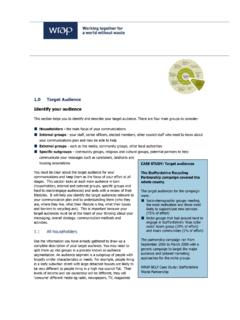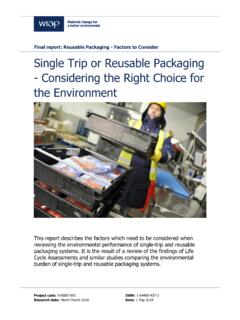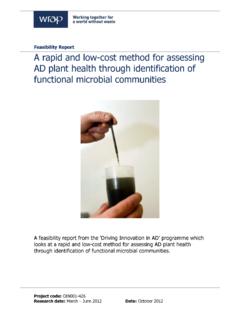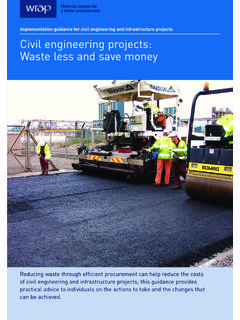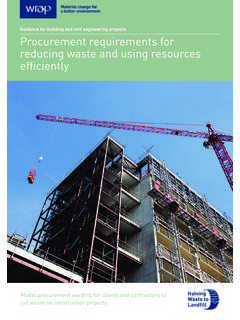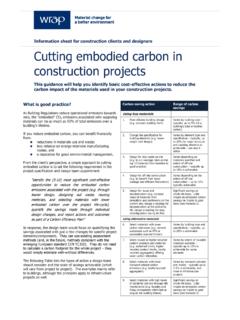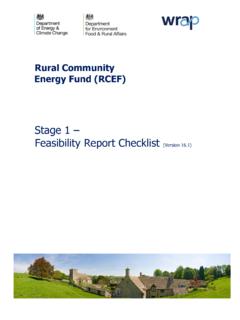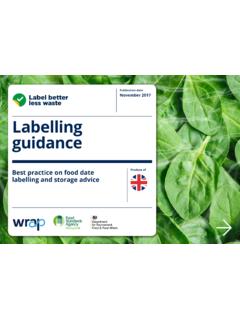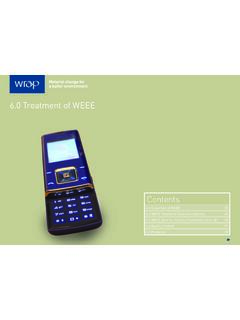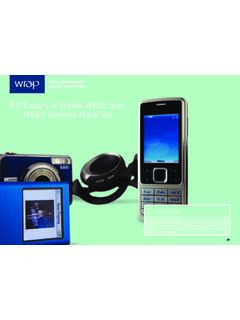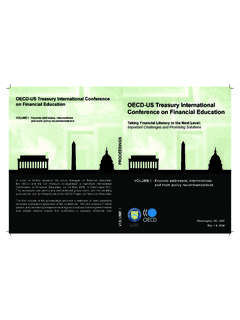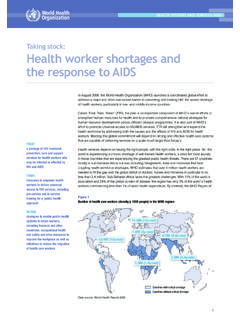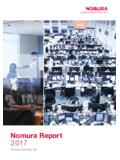Transcription of Education: Taking Action on Waste
1 education : Taking Action on Waste The education Sector next Step 1 Measure and monitor Step 2 Develop an Action plan; Ways to Waste less Step 2 (cont.) Develop an Action plan; Ways to recycle more Steps 3 and 4 Review progress and share your good work education : Taking Action on Waste The education Sector Waste is a key issue for the education Sector. Food Waste represents a cost to the education Sector alone of 250 million each year including food procurement, labour, utilities and Waste management costs, or 2,100 per tonne. This information sheet outlines where Waste arises as well as showing how to reduce this Waste and save money. The education Sector Estimated annual statistics show that education catering: serves 14% of all meals eaten out in the UK each year, equivalent to 1,134 million meals; produces 210,700 tonnes of Waste each year in the UK, including 123,000 tonnes of food Waste ; produces 13% of the total food Waste across the Hospitality and Food Service sector in the UK; and the average cost of avoidable food Waste is per meal.
2 Estimated Recycling Rates of UK education Overall, 23% of all Waste is recycled. This is made up of: 8% of food Waste icomposted or sent to anaerobic digestion (AD). 45% of packaging and other wastes are recycled. UK education Sector: the Composition of Food Waste 0%5%10%15%20%25%Why Take Action ? Applying a cost to food Waste demonstrates the true value of what is wasted and the potential savings that can be made. By Taking a few simple steps to Waste less and recycle more, businesses can reap financial as well as environmental benefits. Read on and find out more. education : Taking Action on Waste The education Sector back Step 2 Develop an Action plan; Ways to Waste less Step 2 (cont.) Develop an Action plan; Ways to recycle more Steps 3 and 4 Review progress and share your good work Step 1 Measure and monitor education : Taking Action on Waste next Step 1 Measure and monitor Step 1: measure and monitor food that goes in the bin for a trial period, a week, to understand where and why this Waste arises.
3 Repeat this at least twice a year to measure your progress. This will enable the cost of food Waste to be identified and for progress to tracked over time. For the trial, start collecting food Waste in separate bins, where appropriate. Weigh them so that the amount of food Waste can be compared to other wastes. Alternatively, if separate food Waste collections are in place, your Waste contractor may be able to provide this data. For the trial use three separate bins (one each for preparation, spoilage and plate Waste ), where appropriate. Weigh them daily to find out where the most food Waste is being generated. This should include food that would otherwise have ended up in the sink disposal unit. Calculate the amount of food Waste produced each year from the data collected. Multiply this figure by the cost per tonne ( 2,100) to find out how much this is costing your business each year.
4 Where Does Food Waste Come From? These ratios are general estimates from hospitality and food service research. They can vary according to different kitchen operations and how much food is brought in pre-prepared. Useful Tools WRAP s Online Resource Centre, which includes downloadable tracking sheets: The Unilever Food Solution mobile app for chefs, Wise up on Waste : education : Taking Action on Waste The education Sector back Step 2 Develop an Action plan; Ways to Waste less Step 2 (cont.) Develop an Action plan; Ways to recycle more Steps 3 and 4 Review progress and share your good work Step 1 Measure and monitor education : Taking Action on Waste next Step 2 Develop an Action plan; Ways to Waste less Step 2: develop an Action plan with targets, timescales and responsibilities. Involve your staff. Build in time to measure progress and track how much money is being saved.
5 There are lots of opportunities. Ways to Waste Less Review stock management and food delivery processes for food items with a short shelf life. This can be a simple way to reduce spoilage Waste Run your own chef master classes to reduce food wasted during preparation. Look at ways to improve menu planning by monitoring plate Waste as well as giving consumers more choice, where appropriate, for example by offering a offer a choice of different portion sizes. Redistribute surplus food to charities, where possible. Work with charities such as Plan Zheroes and FareShare. Note: donations must comply with food safety legislation. Train staff so that they are aware of what they can do to help reduce food Waste . Get the Packaging Right Packaging plays a vital role in protecting and preserving food and drink throughout the supply chain. Suppliers may be able to help you manage packaging by: using returnable and re-usable transit packaging for fruit and vegetables; using catering packs which can result in less packaging per unit of product, but only if this is not going to create food Waste because product is not used before it goes out of date; using re-usable packaging and/or serving drinks on tap, refillable drinks bottles; and optimising packaging lighter weight bottles.
6 Useful Tools WRAP s consumer-facing Love Food Hate Waste campaign has a resource pack which can be used to help reduce plate Waste education : Taking Action on Waste The education Sector back Step 2 Develop an Action plan; Ways to Waste less Step 2 (cont.) Develop an Action plan; Ways to recycle more Steps 3 and 4 Review progress and share your good work Step 1 Measure and monitor education : Taking Action on Waste next Step 2 (cont.): ways to recycle more Get the bins right. Incorrect types and numbers of bins can lead to the wrong Waste going in the wrong bin, such as recycling going in with general Waste . Adjusting the size of bins or frequency that they are collected can also save money. Ask the Waste management contractor for your data. Having data on how much Waste is going to landfill, being recycled or going to anaerobic digestion will help to understand current levels of recycling.
7 This information can then be used to identify further opportunities. Monitor how this changes on a regular basis. Do the sums. Recycling Waste doesn t attract landfill tax and may cost less. If you are already recycling packaging, it s worth speaking to the Waste contractor about other services including food Waste collections. Get staff on your side. Engage staff to recycle more by helping them to understand which Waste goes in which bin. It is key for staff to buy in to initiatives so that they see the benefits. This will encourage participation and help increase recycling rates. Work together. Consider working with neighbouring businesses to procure food Waste and recycling collections, where appropriate. There may be efficiencies/economies of scale to be made by working together. Step 2 (cont.) Develop an Action plan; Ways to recycle more Choose the most appropriate Waste management solution for your needs.
8 When entering into a contract for food Waste recycling, or other Waste collections, make sure that the service meets your requirements and won t incur additional costs. Ask questions such as: What type of containers will be provided? What can and can t they recycle? What are the charges; are there any separate charges for bin rental or over-filled bins? What is the process for changing and/or renewing the contract? Useful Links Information and practical advice on food Waste recycling collections, including posters, bin labels, and case studies: Visit to find lots of useful information about recycling, such as signage. Online Waste management course from Nestl Professional: Waste Regulations in Scotland Legislation for the disposal of food and packaging Waste is changing in Scotland from 2014, including a ban on food Waste being disposed of to landfill and to sewer, and a requirement to separate food Waste and certain packaging wastes for recycling: education : Taking Action on Waste The education Sector back Step 2 Develop an Action plan; Ways to Waste less Step 2 (cont.)
9 Develop an Action plan; Ways to recycle more Steps 3 and 4 Review progress and share your good work Step 1 Measure and monitor education : Taking Action on Waste next Step 3: review progress on the plan each month. Speak to staff to get their feedback on the progress being made to keep people involved and motivated. Measure the amount of Waste produced regularly and work out how much money is being saved. Step 4: share your good work with staff, consumers and industry. Keep up-to-date on all the good practice being carried out by looking online the WRAP websites. Apply anything you learn to the plan and update it regularly. Steps 3 and 4 Review progress and share your good work Useful Links Free tools are available to help with measuring and reducing Waste . Access all of these tools and more at Help for organisations across Scotland to save money by using resources more efficiently: Take Action on Waste To find out more about the Hospitality and Food Service Agreement, which is helping industry to take Action on reducing Waste and increasing recycling rates, visit: Self-Service in a Secondary School Following a review of plate Waste from students, a secondary school in Didcot, Oxfordshire, has moved to self-service catering provision.
10 After an initial observation period, the menus were adapted according to what pupils ate, resulting in some food items being completely removed from the menu. This led to a 50% reduction in Waste from the kitchen, as a result of less food Waste being left on the plate and better stock management in the kitchen. education : Taking Action on Waste The education Sector back Step 2 Develop an Action plan; Ways to Waste less Step 2 (cont.) Develop an Action plan; Ways to recycle more Steps 3 and 4 Review progress and share your good work Step 1 Measure and monitor education : Taking Action on Waste next Waste & Resources Action Programme The Old Academy 21 Horse Fair Banbury, Oxon OX16 OAH Tel: 01295 819 900 Fax: 01295 819 911 E-mail: Helpline freephone 0808 100 2040 While we have tried to make sure this document is accurate, neither WRAP nor its associates can accept responsibility or be held legally responsible for any loss or damage arising out of or in connection with this information being inaccurate, incomplete or misleading.
